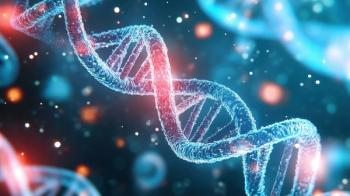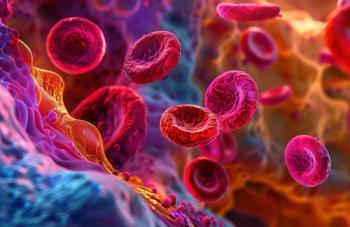
- July 2025
- Volume 31
- Issue Spec. No. 8
- Pages: SP514-SP515
AI Can Boost Accuracy When Classifying HER2-Low, HER2-Ultralow Breast Cancers, Findings Show
Key Takeaways
- Trastuzumab deruxtecan improves survival in HER2-low and HER2-ultralow breast cancer, necessitating accurate patient classification.
- AI significantly enhances pathologists' accuracy in HER2 assessments, increasing eligibility for targeted therapy.
Assistance from artificial intelligence can potenially increase the number of patients eligible for treatment for HER2-low breast cancers.
In recent years, practice changing data have shown that trastuzumab deruxtecan (Enhertu) can improve survival among patients who express the protein human epidermal growth factor receptor 2 (HER2) below the traditional level deemed HER2-positive.
But this created a new challenge: Identifying which patients belong in new classifications, called “HER2-low” and “HER2-ultralow,” is trickier than the old divide of HER2-positive or HER2-negative. Even experienced pathologists can mislabel a patient as HER2-null, which could put life-saving targeted therapy out of reach.
Many have looked to artificial intelligence (AI) for a solution, and results released today by the American Society of Clinical Oncology (ASCO) suggest the wait is over. An international study shows that using AI significantly improved the accuracy and consistency of pathologists’ readings of test results, clarifying which patients should be treated with the trastuzumab dertuxtecan, an antibody drug conjugate (ADC).
Presented in a press briefing by co-author Marina De Brot, MD, PhD, of A.C. Camargo Cancer Center, São Paolo, Brazil, the study involved 105 pathologists from 10 countries in Asia and South America, all tasked with providing HER2 assessments for 20 digital breast cancer cases, first without AI assistance, and then with help from the AI-supported digital training platform ComPath Academy. Use of AI improved both scoring sensitivity—a measure of how well a testing method identifies a condition or lack of one—as well the pathologists’ agreement with the reference scores. Notably, use of AI resulted in more patients being eligible for treatment.
De Brot said that nearly two-thirds of women once considered HER2-negative have some HER2 expression. “Some of these tumors could be treated with HER2-targeted drugs, but only if we detect their HER2 expression levels,” she said in a statement. “Our study provides the first multinational evidence that artificial intelligence can help close a critical diagnostic gap.”
HER2-Low and HER2-Ultralow
New classifications for HER2 expression are the result of a pair of phase 3 trials,
DESTINY-Breast04 found a progression-free survival (PFS) benefit of 50% compared with chemotherapy among patients previously treated for metastatic HER2-low disease. The classification refers to patients diagnosed using immunohistochemistry (IHC) and in situ hybridization (ISH) tests who have an IHC score of 1+ or 2+ without gene amplification (ISH).
Two years later, results from DESTINY-Breast06 identified an additional group of patients labeled HER2-ultralow, based on an IHC score of 0 with membrane staining, which meant less than 10% of the tumor cells showed faint membrane staining. In this trial of patients who had progressed on 1 or more endocrine therapies in a metastatic setting, trastuzumab deruxtecan produced a 36% reduction in the risk of disease progression or death compared with chemotherapy.
FDA has since
Diagnoses Prove Challenging
Since these approvals, De Brot noted in a press briefing, physicians and pathologists in daily practice have encountered the limits of existing diagnostic tools. “These new subcategories have become targetable for breast cancer specific therapy, but the challenges on assessment of HER2-low levels of expression remain,” she said.
A
They wrote, “While clinical trial data support targeting HER2-low expression in patients, the biological distinction of HER2-low tumors as a separate entity remains unclear.”
At the same time, the authors held out hope that AI could offer a solution, with technology “going beyond what the human eye can perceive.”
AI Tool Brings Greater Consistency
De Brot explained that pathologists performed a total of 1940 readings during 3 separate exams. The first 2 exams did not have AI support, while the last one did. Readings were compared against “ground-truth” IHC scores from a central reference center. An ASCO statement explained that ground-truth scores are developed through a consensus among multiple expert pathologists who independently review and score HER2 IHC-stained tissue samples; they are the reference point for determining HER2 breast cancer status.
The study found:
- Pathologists achieved an average of agreement of 76.3% with the reference scores on the first 2 exams, compared with 89.6% on the final exam. For HER2 clinical categories (null, ultralow, low, and positive) accuracy moved from 66.7% without AI to 88.5% with AI.
- Misclassification of HER2-ultralow cases as HER2 null occurred in 29.5% of readings without AI assistance but fell to 4.0% with help from AI—thus, with AI, more patients would be potentially classified as eligible for treatment with an ADC.
More research is planned, De Grot said, including implementation studies that will embed the AI tool into the diagnostic workflow to measure downstream clinical effects. Studies will measure how use of AI changes treatment decisions as well as time to therapy.
“Accurate HER2 scoring is important to ensure that patients receive the best treatment for their breast cancer,” Julian Hong, MD, MS, associate professor and medical director, Radiation Oncology Informatics at the University of California, San Francisco, said in an ASCO statement. “This international study shows that an AI-assisted approach improved HER2 scoring, including in situations that would affect treatment decisions. These findings shed light on the promising role for AI in oncology, not as a replacement for the physician, but as a powerful tool to help us work smarter and faster to deliver high-quality, more personalized care.”
AstraZeneca, a sponsor of trastuzumab deruxtecan, funded the study.
References
- Mulder D, Shabaan A, Lacroix-Triki M et al.Use of artificial intelligence–assistance software for HER2-low and HER2-ultralow IHC interpretation training to improve diagnostic accuracy of pathologists and expand patients' eligibility for HER2-targeted treatment. Presented at: American Society of Clinical Oncology Annual Meeting, May 31-June 3, 2025, Chicago, IL: Abstract 1014.
- Modi S, Jacot W, Yamashita T, for the DESTINY-Breast04 Trial Investigators.Trastuzumab Deruxtecan in Previously Treated HER2-Low Advanced Breast Cancer. N Engl J Med. 2022 Jul 7;387(1):9-20. doi: 10.1056/NEJMoa2203690.
- Bardia A, Hu X, Dent R, et al, for the DESTINY-Breast06 Trial investigators. Trastuzumab deruxtecan after endocrine therapy in metastatic breast cancer. N Engl J Med. 2024 Dec 5;391(22):2110-2122. doi: 10.1056/NEJMoa2407086.
- Shaaban AM, Kaur T, Provenzano E. HER2-low breast cancer—current knowledge and future directions. Medicina. 2025;61(4):644. doi:
10.3390/medicina61040644
Articles in this issue
Newsletter
Stay ahead of policy, cost, and value—subscribe to AJMC for expert insights at the intersection of clinical care and health economics.












































